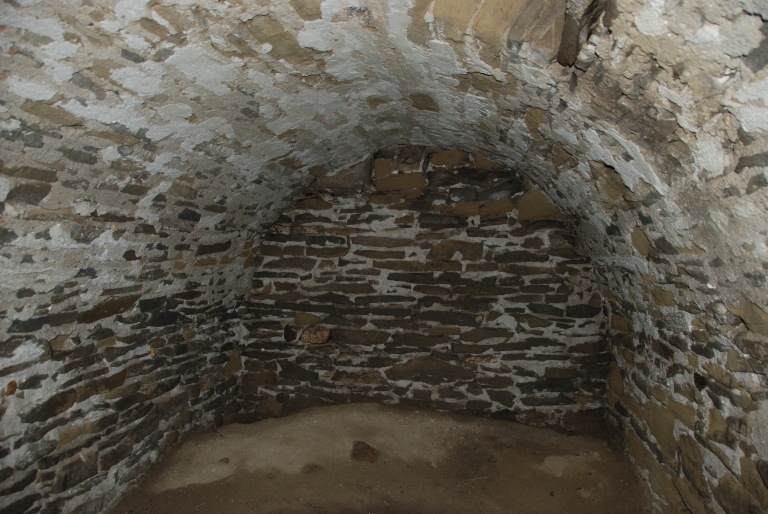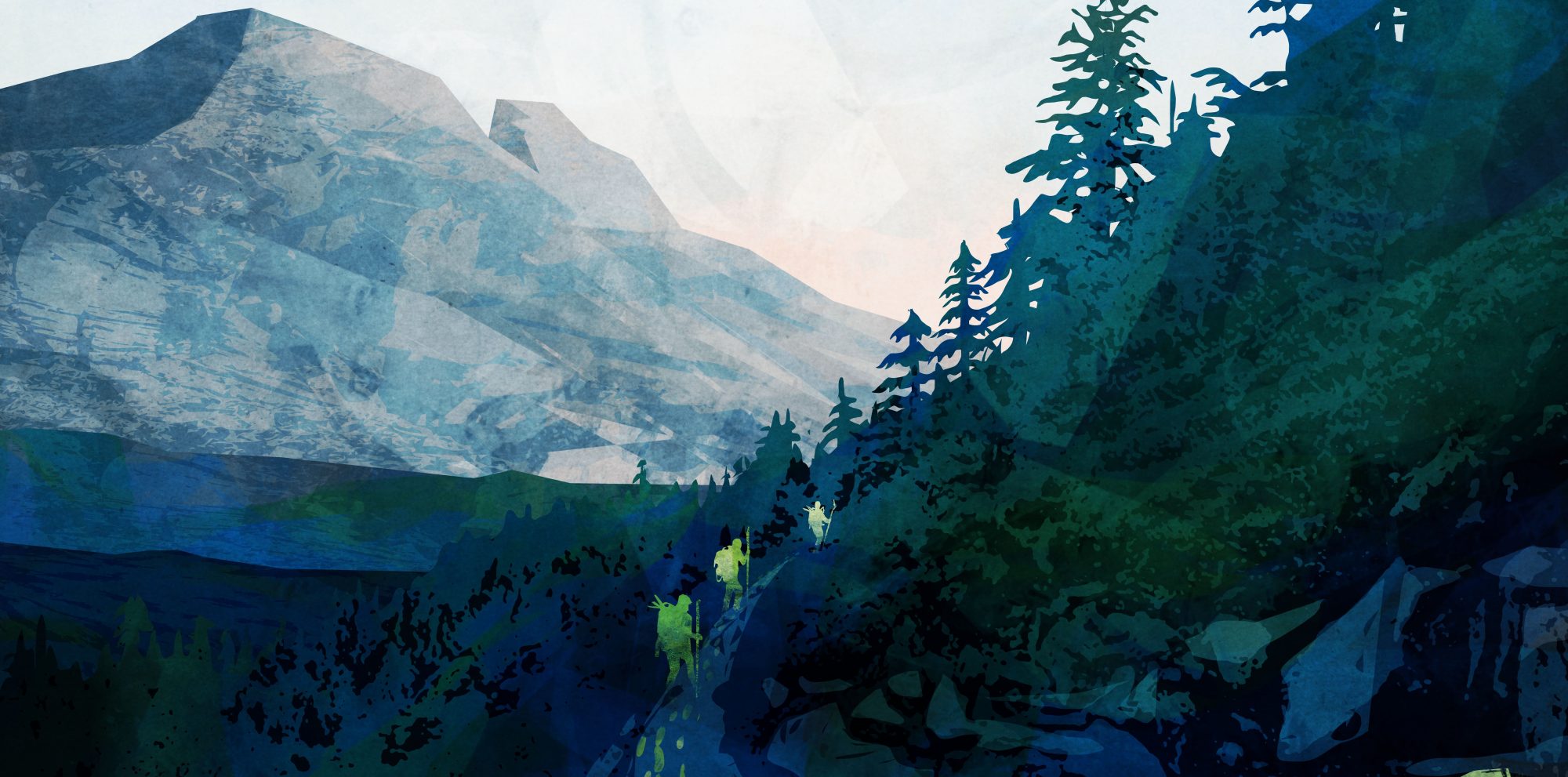The Mysterious Sunnyslope Sandstone Shelter
There is a peculiar overgrown mound in a farmer’s field in Kneehill County, near the town of Three Hills. A weathered wooden door hung within a stone-frame sits against the embankment. The door opens onto a sandstone staircase leading downward into a vaulted, stone chamber. Welcome to the Sunnyslope Sandstone Shelter—what must be Alberta’s strangest starter home. We know that the builder must have been a skilled stonemason, but unfortunately we know little else about the craftsman or how the shelter was built. The one-of-a-kind shelter was designated a Provincial Historic Resource in January of 2011. This post will look at some of the theories we have developed in trying to solve the mystery of the origins of the Sunnyslope Sandstone Shelter and its current condition.

The Sunnyslope Sandstone Shelter is significant for how sandstone was used to build its walls, ceiling and archway door. We estimate the shelter to have been built between 1900 and 1905. This makes the structure distinct when compared with other early homes that would have been built in Alberta around the same time.
A few theories have emerged over the years. Initial investigation of homestead records and local stories led many to believe that a George Schech built the shelter. Schech was reputedly a German immigrant and stonemason who came to Alberta in 1903 or 1904 after living in Wisconsin, Montana or Washington for a time. He apparently lived in the shelter while a frame house was being built on the same quarter section of land. Afterwards, it became a root cellar. Little else is known about Schech, as he apparently abandoned the farm and returned to the United States after only a few years of living on the homestead.

Another plausible theory emerged from our research and later on from additional oral history in the Three Hills area. The other theory is that the shelter was built in 1902 by a Mr. Stein who, like Schech, was also a stonemason from Germany. However, there is no existing record of a Stein homesteading in the area. There is evidence that Erick C. Stendahl or Erich Steendahl settled on the land that contains the Sunnyslope Shelter. It may be that “Stein” is an adaptation of Stendhal. However, Canadian census records state that Stendahl was originally from Norway, not Germany, and lists 1905 as his year of immigration to Canada. Additionally, a Declaration of Abandonment issued by the Dominion Lands Office for this quarter section was signed by Erich C. Steendahl in 1903. George Schech applied for a homestead on this land shortly thereafter. This further complicates the issue by not having definitive evidence to reference and verify. The information that has been compiled for both Schech and Stein or Stendahl is based on correspondence with residents from the area, census and homestead records.
Homesteaders who came to Alberta would construct a small temporary shelter, such as a tent, dugout or shack, before building a larger and more modern house. In that respect, Sunnyslope is no different. Early dugout houses in Alberta were shallow pits, often built into an embankment, with roofs made from poles, mud plaster and sod. Sod houses were usually the first “permanent” home built by a homesteader during the end of the nineteenth and early twentieth century in areas without trees. Later on, a more solid structure, usually a wooden, frame house, was constructed for permanent habitation. A variety of building techniques were used throughout Alberta during this period, but stone construction is unique and Sunnyslope has load-bearing sandstone walls and a vaulted, sandstone ceiling.
This design is more fitting to the Great Plains of the United States, where dugouts were used as storm shelters. Stone became a popular option in areas of the American West and Midwest because there were fewer trees, and stone better shielded the little room inside from extreme weather, such as tornadoes. Structures like this were also used as temporary homes and storage cellars for supplies, fruit and vegetables.

Stonemasonry was much less common for simple buildings in Alberta, which makes the architecture of the shelter unique, but raises the question: why sandstone? A possible explanation is that the builder was influenced by the techniques used by homesteaders on the Great Plains of the United States, after residing there for some time. Since it appears that the builder of Sunnyslope was a stonemason, it is likely that he would have used the skills he was most familiar with to construct a first home.
The Sunnyslope Sandstone Shelter is stable and the interior has remained intact for more than a century—all of which is a testament to the skill of the builder. The stone archway itself was rebuilt in 1978, when a new wooden door was also added. The use of mortared sandstone and distinct stone stairway remain the most significant elements of the structure. The site shows the innovations that were made by early homesteaders and their need for a quickly constructed living shelter, while revealing the realities of a temporary habitat for early settlers to the area.
The mystery of the site’s origins highlight Alberta’s exciting heritage and show the fascinating stories that have contributed to our history. While there are conflicting reports over who was responsible for the shelter’s construction, this tale shows the fun of reconstructing a 100 year old story. There is evidence to suggest that Schech or Stendahl (Stein?) could have built the shelter, but how can we know for sure?

Can you help us solve this whodunit? We invite all you history sleuths to leave your comments and perhaps help us piece together the puzzle. Any information, tips or stories can assist with creating a clearer picture of the past.
For additional details on the Sunnyslope Sandstone Shelter, refer to the Alberta Register of Historic Places. Homes in Alberta: Building, Trends, and Design 1870-1967, by Donald Wetherell and Irene Kmet provides more information on early homestead construction in the province.
Written by: Erin Hoar, Historic Resources Management Branch Officer.
Sources
“1906 Canada Census of Manitoba, Saskatchewan, and Alberta.” RG31, Statistics Canada. Library and Archives Canada. (Accessed July 8, 2014).
“1916 Canada Census of Manitoba, Saskatchewan, and Alberta.” R233-47-9-E. Library and Archives Canada. (Accessed July 8, 2014).
Designation file #Des. 312, in the custody of the Historic Resources Management Branch.
“Sunnyslope Sandstone Shelter.” Alberta Register of Historic Places. HeRMIS. (Accessed July 8, 2014).
Wetherell, Donald G., and Irene R. Kmet. Homes in Alberta: Building, Trends, and Design 1870-1967. Edmonton, Alberta: University of Alberta Press, 1991.


Here’s some more speculation…
My grand parents’ ranch had an ice house for storing ice cut each winter and storing beef in the summer, as well as a root cellar for winter storage for (lots of) vegetables. Both were wood construction with straw and sawdust insulation, and both were more protected in various ways than this stone structure.
As a root cellar it seems too exposed and with too much stone. Unless it had a house over it, I’d bet if froze in AB winters. It could be a failed root cellar.
It could have been built by someone familiar with (perhaps wiped out by) mid-west US tornadoes.
If it was on a slope somewhere, it might have been a spring or well house.
And, there are little stone buildings in AB that were used for storing creamery cans of milk and cream. These usually had a deliberate depression in the floor for cold water, and probably had a spring or well nearby.
Or, perhaps someone imagined a cheesiry in the building.
It might simply have been a transition space. I remember as late as the 1960s rural homes starting as a roofed basement that was built up over time.
Whatever the intent of this structure, it may, like the homesteaders, have not have been successful in its purpose.
Fascinating…
Where did the stone come from? Was it collected in the fields or was it quarried close by?
I lived by it and visited a number of times
The stone is just field stones which were just gathered from the area
There was (is) lots of rocks left there due to ancient glacier movement
You see piles of them in every field
That’s on my brother-in-law’s land, I think. It was built by a Dutch immigrant. He arrived in the fall and had to quickly build himself a shelter. He was a mason in his homeland. I think it was in the 1930’s. Inez Page of Three Hills would have all the details.
I grew up with this shelter about 2 minutes away where the 582 does it’s 1 mile north south correction. I’ve circled a tractor around this structure more then a couple times.
For the record. It’s known as “The One Man’s Castle” at least we grew up with that name which we got from our grand parents who also grew up with it in their back yard. I think it’s been called the one man’s castle for many years.
Personally, I think It was brilliant. What better in this at sometimes windy part of the province. Winters are harsh even in this time period, hard to imagine what it was like back then. Being underground was genius…I would think the stone was easier to find than wood, and if your a stonemason what better. It’s actually what I have thought would be a perfect place to live…underground !
It was built by a Mr. Scheck (not sure about the spelling) he was a homesteader from the USA, For years after he left it was used as a root cellar. It was and still is maintained by the Derek Page family.( information came from Marj Vetter long time resident from the area)
There used to be a laminated sign at the site explaining its history. I’ve also visited many times
My Grandparents had a farm nearby. I was shown the place in the early 60’s, then we would sneak back on our bikes and used it as a fort while shooting our bb guns at each other…if you won the toss you got the inside…perhaps the Hillbilly recalls those times?
.i grew up being told it was a root cellar…there used to be a ledger inside noting if i recall, potatoes
The ledger on the door or in the tin box has a lists of names that have visited. Inez Page kept a collection of the books names as they filled up over the years, Derek Page or Connie Neufeld would know what’s become of them. Last I looked there was still a book in there.
Hillbilly is me: I don’t I didn’t exist in the 60 or the 70s, it wasn’t until the dawn of the 80s that god blessed the earth with my existence and knowledge of the One Man’s Castle.
Sandstone was collected west of the location along the cliffs of a small lake then hauled a couple miles to that location.
We were told a youth died at the mine years ago.